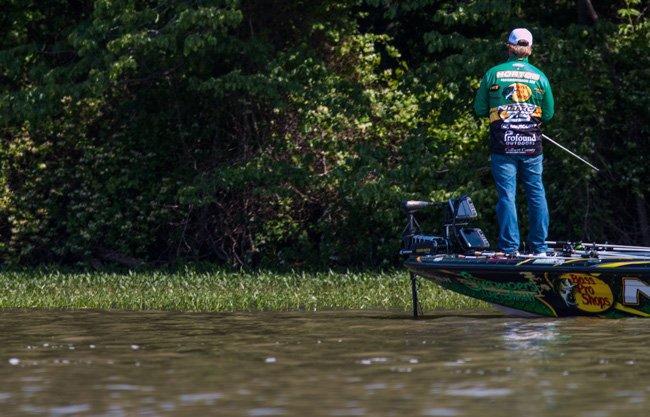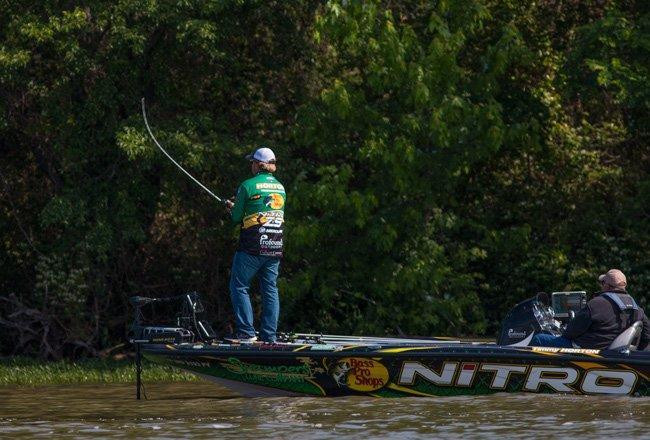If you’ve been on the water recently, you might have noticed an eerie vacancy at some of your favorite boat ramps. Sure, school has once again started and the pleasure boating season is quickly coming to an end, but there’s another explanation for the lack of bass fishing activity. The fall transition period is, and always has been, a frustrating time for anglers.
Despite its reputation, Elite Series pro Timmy Horton believes this is one of the best times of the entire year to catch big numbers of quality bass. While the attention of many anglers switches to upcoming hunting seasons, he uses these simple tips to quickly locate transitioning fall bass.
Avoid tunnel vision
Throughout much of the year, the number of fishing rods on an angler’s front deck can serve as a fairly reliable indicator of their recent bass fishing success. It’s often assumed that the folks with a few select rods are on a specific pattern while the ones with dozens of rods are struggling to find a consistent bite. That’s certainly not the case right now.
“I absolutely love fishing the fall transition period because there are so many great patterns happening at once. If you can keep an open mind and integrate multiple patterns throughout your day, your chances of success will skyrocket.” Â
“I absolutely love fishing the fall transition period because there are so many great patterns happening at once,†Horton said. “It’s easy to struggle this time of year because we often get tunnel vision. If we think the bass are shallow, we fish shallow. And if we think they’e deep, we spend all of our time in deep water. If you can keep an open mind and integrate multiple patterns throughout the day, your chances of success will skyrocket.â€
So why are there so many possibilities right now? Horton believes three primary factors contribute to this wide variety of bass behavior.
- Shad dictate bass movementâ€â€Ã¢â‚¬Å“I really believe that the bass move to and from shallow water based on shad behaviorâ€â€not necessarily water temperature or current flow,†Horton said. “They go where the shad are and, coincidentally, there are two separate populations of shad right now.â€Â
- Shallow shadâ€â€Ã¢â‚¬Å“The shad fry that hatched in June and July are finally getting big enough for the bass to feed on them,†Horton said. “This results in a population of bass flooding the shallows much earlier than you’d expect. These shad represent an easy meal and the bass are hot on their tails.â€Â
- Deep shadâ€â€Ã¢â‚¬Å“You can also expect to see a lot of larger shad still hanging around deeper structure such as river ledges and creek ledges,†Horton said. “As the fall approaches and water temperatures continue to cool, these larger shad will eventually move shallow. But until then, this diversity gives anglers opportunities at both ends of the spectrum.â€Â
Focus your efforts on high percentage areas
Being aware of both shallow and deep water shad activity can certainly be advantageous, but it can also become overwhelming. You could certainly adopt the “fish it all†approach and try every possible location, but narrowing your approach to the most high percentage areas will save you a lot of time and, in many cases, frustration.
“Bass behavior and positioning can be very volatile right now,†Horton said. “It’s important to understand that your shallow bite is often at its best in the mornings and your deep water bite will take over as the sun gets higher during the day. The bass will move shallow overnight to feed and when the light penetration becomes too much for their sensitive eyes, they’ll gradually slide out to deeper cover and structure.â€
Horton’s staples for the fall transition
- Topwaters: Azuma Popper Z (target casting), Azuma Z Dog (covering water)
- Jigs: 3/4-ounce Swampers Lures Football Jig  (deep structure), 7/16-ounce Swampers Lures Flipping Jig (shallow cover)
- Crankbaits: Azuma Z-Boss 20
As is the case with every bass fishing season, it’s important to spend your time efficiently by targeting areas known to play host to active bass. Over his long career, Horton has found the following areas to be hotspots throughout the fall transition period.
- Seawalls: “In stained water, bass still have to know where they are,†Horton said. “Just like you’d feel for the walls to navigate in a smoke-filled room, the bass do the same thing with seawalls in areas with low visibility. Seawalls can be loaded with roaming bass, especially in the early mornings.â€
- Grass lines: “If you can find a grass line adjacent to deep water, you can expect to catch some great bass right now,†Horton said. “Shallow bass can use these edges as ambush points for smaller shad and deeper bass can slide up early the day, get an easy meal and fall back into the deeper water to concentrate on larger shad.â€
- Docks: “When the bass are in this in-between mode, docks are always a staple for me,†Horton said. “Docks create shade all day which, in turn, attracts resident fish. I’ll start at the front of a pocket and quickly fish all of the nearby docks while making mental notes of my bites. By the time you’re done, you have a very easy-to-duplicate pattern that can work lake wide.â€
- Bridges: “This time of year, you have bass moving to shallow water each day,†Horton said. “Bridges act as bottlenecks that concentrate migrating bass into a small, predictable area. I love to target the corners of the riprap and also the pilings because they offer consistent shade.â€
- Deep brush: “Deeper brush piles can pump out some monster bass right now,†Horton said. “Those fish that get shallow in the mornings will often relocate into these piles as the day warms. It’s not uncommon for me to concentrate on seawalls in the mornings and slide out to deep brush around lunchtime.â€Â
Take advantage of your strengths
Every bass angler has a certain skillset with which they are most comfortableâ€â€some people primarily target deep bass with their electronics while other anglers prefer to fish dirt-shallow water. It all comes down to confidence, which can be enormously important when deciphering a game plan during the fall transition.
“Growing up on TVA fisheries, I’m probably most confident when I’m using my Raymarine units to find those last schools of deep bass,†Horton said. “Early in the transition period, I’ll focus on very specific depth ranges located above the thermocline. As the season progresses and that thermocline breaks up, I’ll broaden my search and focus anywhere from the 15 to 30-foot range.â€Â
Want to learn more about thermoclines and late-summer bass biology? Check out this recent feature.
If you don’t own high-end electronics, however, don’t worry. If you stick to a shallow water approach, you can actually use it to your advantage.
“Covering shallow water quickly with reaction baits is an overlooked strategy this time of year,†Horton said. “This type of fishing is getting a lot less pressure due to the advancements in electronics, so you’ll often have these areas all to yourself. Because these bass aren’t being bothered as much, they’ll usually bite when you put a lure in front of them. It’s an easy way to have an awesome time out there.â€Â
Use the lack of boat traffic to your advantage this month. Instead of waiting for the shallow bite to fully develop, spend some time locating those in-between transitioning fall bass. Whether you’re a beginner or experienced angler, Horton’s tips will keep your thumbs raw in a time when many anglers struggle.













